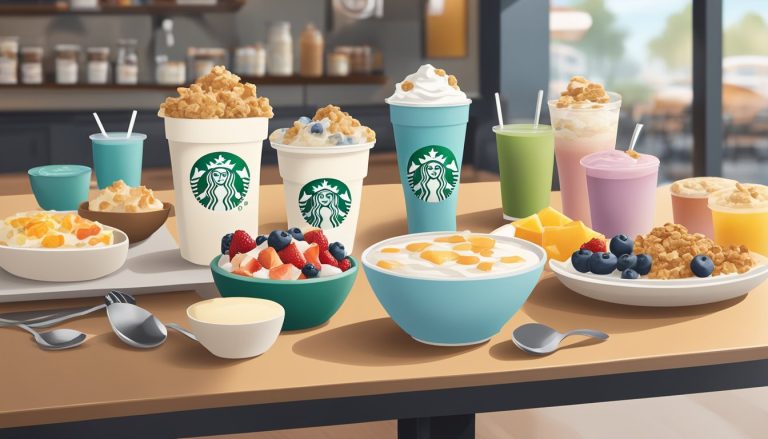Starbucks has become a popular breakfast destination for many people seeking a quick and convenient meal to start their day. While the coffee chain offers a variety of options, some choices can be high in calories, sugar, and unhealthy fats. Making healthier choices at Starbucks can help you maintain a balanced diet and support your overall wellness goals.
For those looking to improve their Starbucks breakfast routine, there are several strategies to consider. By making simple swaps and being mindful of portion sizes, customers can enjoy a satisfying meal without compromising their health. This article will explore 12 practical ways to make your Starbucks breakfast healthier, allowing you to fuel your morning while staying on track with your nutrition goals.
1) Opt for oatmeal instead of pastries

Choosing oatmeal over pastries at Starbucks can significantly improve the nutritional value of your breakfast. Oatmeal provides a hearty, fiber-rich meal that keeps you feeling full longer.
Starbucks offers classic and blueberry oatmeal options, both of which are healthier alternatives to sugary pastries. These oatmeal choices contain whole grains and are lower in calories and added sugars compared to muffins or danishes.
Oatmeal also offers more flexibility for customization. Customers can add nuts, fresh fruit, or a drizzle of honey to enhance flavor and nutrition without drastically increasing calorie content.
The fiber in oatmeal helps stabilize blood sugar levels, preventing energy crashes often associated with high-sugar pastries. This can lead to improved focus and productivity throughout the morning.
For those watching their weight, oatmeal is a smarter choice. It typically contains fewer calories than pastries, making it easier to maintain a balanced diet while still enjoying a satisfying breakfast at Starbucks.
2) Choose almond milk over whole milk

Selecting almond milk instead of whole milk can significantly reduce calorie intake in Starbucks beverages. Almond milk contains fewer calories, with approximately 80 calories per serving compared to whole milk’s higher calorie content.
Almond milk is also lower in saturated fat, making it a heart-healthy choice for those watching their fat intake. It provides a good source of vitamin E, which acts as an antioxidant in the body.
For customers with lactose intolerance or dairy sensitivities, almond milk offers a plant-based alternative that doesn’t compromise taste. It adds a subtle nutty flavor to drinks, complementing coffee and tea flavors well.
Opting for almond milk can help reduce sugar consumption. It typically contains less sugar than whole milk, especially in its unsweetened form. This makes it a suitable option for those monitoring their sugar intake or managing diabetes.
Almond milk’s lower carbohydrate content appeals to individuals following low-carb diets. It provides a way to enjoy favorite Starbucks beverages while adhering to dietary goals.
3) Request unsweetened beverages

Many Starbucks drinks come pre-sweetened with syrups or added sugars. Opting for unsweetened versions can significantly reduce calorie and sugar intake.
When ordering, specifically ask for the beverage without any sweeteners or syrups. This applies to hot and cold drinks alike, including coffees, teas, and specialty beverages.
For those who prefer some sweetness, consider adding a natural low-calorie sweetener like stevia or a small amount of honey. These alternatives can provide flavor without the excessive sugar content of standard syrups.
Unsweetened drinks allow customers to appreciate the natural flavors of coffee and tea. Over time, taste buds may adjust to less sweetness, making it easier to enjoy these healthier options.
Remember that milk alternatives like almond or oat milk can add their own sweetness to drinks. Factor this in when deciding whether to add any additional sweeteners to your beverage.
4) Add a banana or apple to your meal

Adding a banana or apple to your Starbucks breakfast is a simple way to boost its nutritional value. These fruits provide essential vitamins, minerals, and fiber to complement your meal.
Bananas are an excellent source of potassium and vitamin B6. They offer a natural sweetness and can help satisfy hunger. Slice a banana onto your oatmeal or yogurt parfait for added flavor and nutrition.
Apples are rich in antioxidants and fiber. They provide a satisfying crunch and can help regulate blood sugar levels. Pair an apple with your breakfast sandwich or protein box for a well-rounded meal.
Both fruits are portable and convenient, making them ideal additions to any Starbucks order. They can be easily eaten alongside your coffee or tea, providing a balanced start to your day.
By incorporating these fruits, you increase your daily fruit intake and add valuable nutrients to your breakfast. This small change can have a positive impact on your overall diet and energy levels throughout the morning.
5) Use cinnamon instead of sugar for flavor

Cinnamon offers a delicious way to enhance the taste of Starbucks breakfast items without adding extra sugar. This aromatic spice can provide a subtle sweetness and warming flavor to various menu options.
Customers can request a sprinkle of cinnamon on top of their oatmeal or yogurt parfait instead of brown sugar or honey. The spice adds depth to these dishes without contributing additional calories.
For those ordering hot beverages, asking for cinnamon powder on top of cappuccinos or lattes can reduce the need for sugary syrups. Some Starbucks locations also offer cinnamon as a sugar-free flavoring option for coffee drinks.
Adding cinnamon to baked goods like muffins or scones can allow for a reduction in sugar content while maintaining an appealing taste profile. This spice pairs particularly well with apple and banana-based breakfast items.
Cinnamon not only enhances flavor but may also offer potential health benefits. Some studies suggest it could help regulate blood sugar levels, though more research is needed to confirm these effects.
6) Order a protein box instead of a muffin

Starbucks protein boxes offer a more nutritious alternative to muffins. These boxes contain a variety of foods that provide a balance of protein, complex carbohydrates, and healthy fats.
Typical protein boxes include options like hard-boiled eggs, cheese, nuts, and fresh fruits or vegetables. These ingredients offer sustained energy and help maintain stable blood sugar levels throughout the morning.
In contrast, muffins are often high in sugar and refined carbohydrates. While they may provide a quick energy boost, this is often followed by a crash later in the day.
Protein boxes also tend to be more filling than muffins. The combination of protein and fiber helps promote satiety, potentially reducing overall calorie intake.
For those looking to increase their protein intake, these boxes are an excellent choice. They generally contain 15-20 grams of protein, significantly more than most muffins.
DIY versions of Starbucks protein boxes can be made at home for a fraction of the cost. This allows for customization based on personal preferences and dietary needs.
7) Select a spinach and feta wrap
The spinach and feta wrap is a popular breakfast choice at Starbucks. It offers a balance of protein, vegetables, and whole grains, making it a nutritious option to start the day.
This wrap contains egg whites, spinach, sun-dried tomatoes, and feta cheese. These ingredients are bundled in a whole wheat tortilla, providing complex carbohydrates and fiber.
The egg whites in the wrap are a lean source of protein. Spinach adds essential vitamins and minerals, while sun-dried tomatoes contribute flavor and antioxidants.
Feta cheese provides calcium and adds a tangy taste to the wrap. However, those watching their sodium intake should be aware that feta can be high in salt.
For a homemade version, one can use a large whole wheat tortilla and fill it with egg whites, fresh spinach, diced tomatoes, and a sprinkle of feta. This allows for control over ingredients and portion sizes.
When ordering at Starbucks, customers can request the wrap to be heated for a warm, satisfying meal. Paired with a coffee or tea, it makes for a filling breakfast under 300 calories.
8) Ask for no whipped cream

Whipped cream adds unnecessary calories and sugar to Starbucks breakfast items. Requesting your order without this topping can significantly reduce the overall calorie content of your meal.
Many Starbucks beverages come standard with whipped cream. Opting out of this addition can save between 60 to 110 calories per serving, depending on the drink size.
For hot drinks like mochas or flavored lattes, skipping the whipped cream allows you to enjoy the core flavors without the extra sweetness. This small change can make a big difference in your daily calorie intake.
Cold drinks such as Frappuccinos also benefit from this modification. Without whipped cream, these blended beverages become lighter while still maintaining their signature taste.
Remember that you can always customize your order. Starbucks baristas are accustomed to requests for “no whip” and will happily accommodate your preference for a healthier breakfast option.
9) Customize with fewer pumps of syrup

Starbucks beverages often come with a generous amount of flavored syrup, which can significantly increase calorie and sugar intake. Standard drinks typically contain three to six pumps of syrup, depending on the size.
Customers can easily reduce the sweetness and calorie content of their drinks by requesting fewer pumps of syrup. This simple customization allows for a more balanced flavor profile while cutting down on excess sugar.
For those who enjoy flavored beverages but want to make healthier choices, asking for one or two pumps instead of the standard amount can make a noticeable difference. This adjustment maintains the desired taste without overwhelming the palate with sweetness.
Alternatively, patrons can opt for sugar-free syrup options when available. These provide flavor without adding calories or sugar to the drink. By making this small change, customers can enjoy their favorite Starbucks beverages while aligning with their health goals.
10) Switch to a plain cappuccino

A plain cappuccino is a smart choice for those looking to make their Starbucks breakfast healthier. This classic Italian coffee drink consists of espresso, steamed milk, and a layer of milk foam.
Cappuccinos are naturally lower in calories and sugar compared to many flavored coffee beverages. A standard 16-ounce cappuccino at Starbucks contains around 140 calories and 8 grams of sugar.
For an even healthier option, ask for nonfat milk in your cappuccino. This simple swap can reduce the calorie content to about 80 calories while still providing a rich, creamy taste.
The milk in a cappuccino offers nutritional benefits, including protein and calcium. These nutrients can help support bone health and muscle function.
By choosing a plain cappuccino, you avoid the added sugars and syrups found in many specialty coffee drinks. This can help reduce your overall sugar intake and support better blood sugar control.
11) Incorporate a hard-boiled egg

Adding a hard-boiled egg to your Starbucks breakfast can significantly boost its nutritional value. Hard-boiled eggs are an excellent source of high-quality protein, essential vitamins, and minerals.
Eggs contain vital nutrients like vitamin D, zinc, and antioxidants such as lutein and zeaxanthin, which promote eye health. They also provide about 6 grams of protein each, helping to keep you feeling full and satisfied throughout the morning.
Consider pairing your Starbucks coffee with a hard-boiled egg and a piece of fruit for a well-rounded meal. This combination offers a balance of protein, carbohydrates, and healthy fats.
For added flavor and nutrition, slice the hard-boiled egg and add it to a Starbucks sandwich or wrap. This simple addition can transform a carb-heavy breakfast into a more balanced meal.
Remember to peel the egg before eating and dispose of the shell properly. By incorporating a hard-boiled egg into your Starbucks breakfast, you’re making a smart choice for your health and energy levels.
12) Choose avocado spread over butter

Opting for avocado spread instead of butter can significantly boost the nutritional value of your Starbucks breakfast. Avocado spread offers heart-healthy monounsaturated fats and essential nutrients like potassium and fiber.
Starbucks’ avocado spread is a vegan and keto-friendly option, making it suitable for various dietary preferences. It’s made with simple, wholesome ingredients and provides a creamy texture similar to butter.
The spread adds a rich, savory flavor to breakfast items without the saturated fat content of butter. It pairs well with toast, bagels, and breakfast sandwiches, enhancing both taste and nutritional value.
For those watching their calorie intake, avocado spread can be a smart choice. While it’s calorie-dense, its nutrient profile and satiety factor can contribute to feeling fuller for longer.
By choosing avocado spread, customers can incorporate more plant-based options into their morning routine. This small change can be part of a larger strategy to make Starbucks breakfasts healthier and more balanced.
Understanding Nutritional Information

Deciphering nutrition labels and identifying hidden ingredients are crucial skills for making healthier choices at Starbucks. These abilities enable customers to select breakfast options that align with their dietary goals and nutritional needs.
Reading Labels Effectively
Starbucks provides nutritional information for most menu items. Calories are typically displayed prominently. Pay attention to serving sizes, as some items may contain multiple servings. Focus on key nutrients like protein, fiber, and sugar.
Protein and fiber contribute to satiety, while excessive sugar can lead to energy crashes. Compare similar items to find healthier alternatives. For example, the Spinach, Feta & Egg White Wrap contains 20g of protein and 3g of fiber, making it a nutritious choice.
Look for items with lower sodium content, especially in breakfast sandwiches. The Classic Oatmeal is a good option with only 125mg of sodium per serving.
Identifying Hidden Sugars
Sugar can lurk in unexpected places at Starbucks. Many breakfast items contain added sugars, even those that seem savory. Check ingredient lists for terms like sucrose, fructose, or corn syrup.
Flavored drinks often contain significant amounts of sugar. A Grande Caramel Macchiato has 25g of sugar. Opt for sugar-free syrups or unsweetened beverages to reduce sugar intake.
Baked goods are common sources of hidden sugars. The Blueberry Muffin contains 29g of sugar. Choose whole grain options or protein boxes for lower sugar content. The Eggs & Cheese Protein Box has only 2g of added sugar.
Be cautious of seemingly healthy options like yogurt parfaits, which can contain high amounts of added sugars. The Berry Trio Yogurt has 29g of sugar per serving.
Incorporating Balance into Your Meal

A balanced Starbucks breakfast includes whole grains, protein, and fiber. These components provide sustained energy and essential nutrients to start your day right.
Choosing Whole Grains
Opt for whole grain options when selecting your Starbucks breakfast. The Rolled & Steel Cut Oatmeal is an excellent choice, offering 7 grams of fiber and 8 grams of protein. This hearty meal keeps you full and provides steady energy throughout the morning.
For sandwich lovers, choose whole grain bread options when available. These contain more nutrients and fiber than their refined counterparts.
Pair your coffee with a whole grain bakery item like a bran muffin or multigrain bagel. These choices offer more vitamins, minerals, and fiber than white flour alternatives.
Adding Protein and Fiber
Incorporate protein-rich options to balance your Starbucks breakfast. Egg bites are a popular choice, providing 12-19 grams of protein per serving. The sous vide cooking method ensures a velvety texture and rich flavor.
Add nuts or seeds to your oatmeal for an extra protein boost. This simple addition also increases healthy fats and fiber content.
Consider ordering a breakfast sandwich with egg whites and turkey bacon. This leaner option still delivers essential protein while reducing overall calorie and fat intake.
For a plant-based protein source, try adding a scoop of plant-based protein powder to your coffee or smoothie. This boosts the nutritional value of your drink without compromising taste.
Customizing Beverage Choices

Starbucks offers numerous options to tailor drinks to individual preferences and health goals. Customers can make smart choices to reduce calories and sugar while still enjoying their favorite beverages.
Opting for Low-Calorie Options
Requesting “skinny” versions of espresso and Frappuccino drinks is an easy way to cut calories. These modifications use nonfat milk, skip the whipped cream, and include sugar-free syrup when available.
Choosing smaller sizes like “tall” (12 oz) instead of larger options can significantly reduce calorie intake. Opting for plain brewed coffee or Caffè Americano provides very low-calorie options under 15 calories per tall serving.
Milk alternatives like almond or coconut milk typically have fewer calories than regular milk. Unsweetened versions are even better for calorie reduction.
Reducing Sugar in Drinks
Asking for fewer pumps of flavored syrups is an effective way to decrease sugar content. Standard recipes often use 3-4 pumps for a tall size, so requesting just 1-2 pumps can make a big difference.
Sugar-free syrup options are available for many flavors, including vanilla, caramel, and cinnamon dolce. These artificial sweeteners provide flavor without added sugar or calories.
Choosing unsweetened tea or coffee-based drinks and adding a small amount of honey or stevia as a natural sweetener allows for better control over sugar intake.
Customizing cold foam with sugar-free vanilla or other calorie-free flavors adds taste without excessive sugar.




